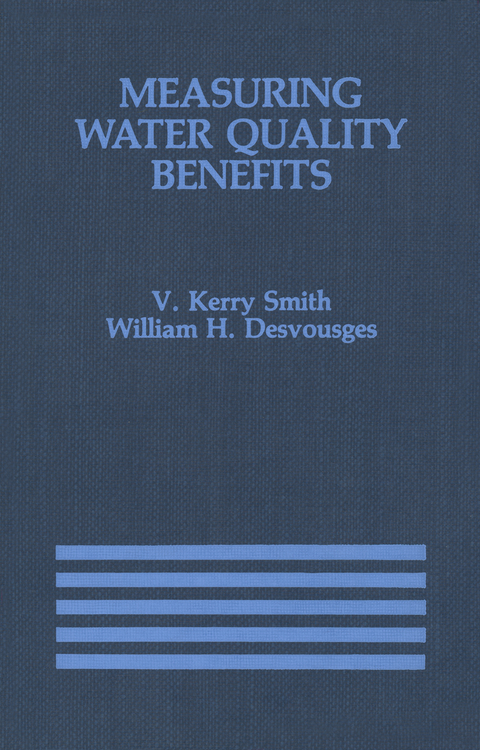
Measuring Water Quality Benefits
Kluwer Academic Publishers (Verlag)
978-0-89838-181-8 (ISBN)
1 Measuring Water Quality Benefits: An Introduction.- 1.1 Background.- 1.2 Regulation: An Overview.- 1.3 Objectives.- 1.4 Preview.- 1.5 References.- 2 The Conceptual Basis of Benefits Estimation.- 2.1 Introduction.- 2.2 A Brief Review of the Conventional Theory of Benefits Measurement.- 2.3 The Treatment of Nonuse Values and Uncertainty in Benefit Analysis.- 2.4 Measuring the Benefits Associated with Changes in Environmental Amenities: An Overview.- 2.5 Benefit Measurement Approaches Considered in This Study.- 2.6 Summary.- 2.7 References.- Appendix: Analytical Background for Valuation Under Uncertainty.- 3 Survey Design.- 3.1 Introduction.- 3.2 The Monongahela River Basin.- 3.3 Sampling Plan.- 3.4 Survey Plan.- 3.5 References.- Appendix: Interviewer Debriefing.- 4 Contingent Valuation Design and Results: Option Price and Use Values.- 4.1 Introduction.- 4.2 Design Issues and Contingent Valuation.- 4.3 Questionnaire Design.- 4.4 Profiles of Survey Respondents.- 4.5 Protest and Outlying Bids.- 4.6 Distribution of Option Price Responses.- 4.7 Mean Option Price Responses.- 4.8 Test Findings: Starting Point and Interviewer Biases.- 4.9 Use Value Results.- 4.10 Implications.- 4.11 References.- Appendix: Additional Empirical Results.- 5 Measuring Option Value.- 5.1 Introduction.- 5.2 Recent Estimates of Option Values.- 5.3 Measuring Option Value: Survey Design.- 5.4 Survey Results—Option Value.- 5.5 Summary.- 5.6 References.- 6 The Contingent Ranking Method and Benefit Estimation.- 6.1 Introduction.- 6.2 The Random Utility Model of Consumer Behavior with Discrete Choices.- 6.3 Estimation of Random Utility Models with Ordered Alternatives.- 6.4 Contingent Ranking and Valuing Public Goods.- 6.5 Applications of Contingent Ranking Method.- 6.6 Monongahela Contingent RankingExperiment: Design and Estimates.- 6.7 Benefit Estimates with Contingent Ranking Models.- 6.8 Implications and Further Research.- 6.9 References.- 7 The Travel Cost Approach to Recreation Demand Modeling: An Introduction.- 7.1 Introduction.- 7.2 The Household Production Framework and Recreation Demand Models.- 7.3 The Opportunity Costs of Time.- 7.4 Measuring Site Usage.- 7.5 Heterogeneous Recreation Sites and Site Characteristics.- 7.6 Summary.- 7.7 References.- 8 Travel Cost Model: Data Sources and Variable Measures.- 8.1 Introduction.- 8.2 Sources of Data.- 8.3 Survey Issues.- 8.4 Data Character.- 8.5 Site Profile.- 8.6 Congestion at U.S. Army Corps of Engineers Sites.- 8.7 Water Quality.- 8.8 Users.- 8.9 Profile of Activities at the Corps Sites.- 8.10 Summary.- 8.11 References.- 9 Generalized Travel Cost Model.- 9.1 Introduction.- 9.2 Implementing the Generalized Travel Cost Model.- 9.3 Estimating the Generalized Travel Cost Model.- 9.4 Valuing Water Quality Changes.- 9.5 Summary.- 9.6 References.- 10 Comparing Direct and Indirect Benefit Estimation Approaches.- 10.1 Introduction.- 10.2 Past Comparisons of Benefit Estimation Approaches: A Review.- 10.3 A Comparison of the Generalized Travel Cost Model and Contingent Valuation.- 10.4 A Comparison of a Simple Travel Cost Model and Contingent Valuation.- 10.5 Comparisons of Benefit Estimation Approaches: Some Interpretations.- 10.6 References.- 11 Research Issues in Benefit Estimation.- 11.1 Introduction.- 11.2 Our Findings: A Perspective.- 11.3 Measuring Nonuse Values.- 11.4 Site Attributes and Recreation Demand.- 11.5 Contingent Valuation Versus Indirect Methods for Benefit Estimation.- 11.6 Benefits Transfer.- 11.7 Prognosis.- 11.8 References.- Appendix A: Survey Questionnaire as Administered During the MonongahelaRiver Basin Survey.
| Erscheint lt. Verlag | 30.9.1986 |
|---|---|
| Reihe/Serie | International Series in Economic Modelling ; 3 |
| Zusatzinfo | XVI, 328 p. |
| Verlagsort | Dordrecht |
| Sprache | englisch |
| Maße | 156 x 234 mm |
| Themenwelt | Naturwissenschaften ► Biologie ► Ökologie / Naturschutz |
| Wirtschaft ► Volkswirtschaftslehre ► Ökonometrie | |
| ISBN-10 | 0-89838-181-9 / 0898381819 |
| ISBN-13 | 978-0-89838-181-8 / 9780898381818 |
| Zustand | Neuware |
| Haben Sie eine Frage zum Produkt? |
aus dem Bereich


